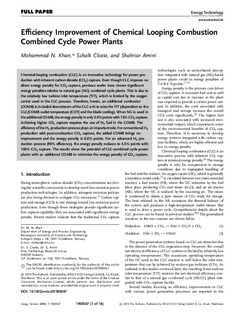| dc.contributor.author | Khan, Mohammed Nazeer Ul Hasan | |
| dc.contributor.author | Cloete, Schalk Willem Petrus | |
| dc.contributor.author | Amini, Shahriar | |
| dc.date.accessioned | 2019-12-02T13:39:09Z | |
| dc.date.available | 2019-12-02T13:39:09Z | |
| dc.date.created | 2019-11-25T17:13:43Z | |
| dc.date.issued | 2019 | |
| dc.identifier.citation | Energy Technology. 2019, 7 (11), . | nb_NO |
| dc.identifier.issn | 2194-4296 | |
| dc.identifier.uri | http://hdl.handle.net/11250/2631284 | |
| dc.description.abstract | Chemical-looping combustion (CLC) is an innovative technology for power production with inherent carbon dioxide (CO2) capture. Even though CLC imposes no direct energy penalty for CO2 capture, previous works have shown significant energy penalties relative to natural gas (NG) combined cycle plants. This is due to the relatively low turbine inlet temperature (TIT), which is limited by the oxygen carrier used in the CLC process. Therefore, herein, an additional combustor (COMB) is included downstream of the CLC unit to raise the TIT (dependent on the CLC/COMB outlet temperature [COT] and the blade cooling). When NG is used in the additional COMB, the energy penalty is only 2.9% points with 72% CO2 capture. Achieving higher CO2 capture requires the use of H2 fuel in the COMB. The efficiency of the H2 production process plays an important role. For conventional H2 production with post-combustion CO2 capture, the added COMB brings no improvement and the energy penalty is 8.8% points. For an advanced H2 production process (90% efficiency), the energy penalty reduces to 4.5% points with 100% CO2 capture. The results show the potential of CLC-combined cycle power plants with an additional COMB to minimize the energy penalty of CO2 capture. | nb_NO |
| dc.language.iso | eng | nb_NO |
| dc.publisher | Wiley | nb_NO |
| dc.rights | Navngivelse 4.0 Internasjonal | * |
| dc.rights.uri | http://creativecommons.org/licenses/by/4.0/deed.no | * |
| dc.title | Efficiency Improvement of Chemical Looping Combustion Combined Cycle Power Plants | nb_NO |
| dc.type | Journal article | nb_NO |
| dc.type | Peer reviewed | nb_NO |
| dc.description.version | publishedVersion | nb_NO |
| dc.source.pagenumber | 16 | nb_NO |
| dc.source.volume | 7 | nb_NO |
| dc.source.journal | Energy Technology | nb_NO |
| dc.source.issue | 11 | nb_NO |
| dc.identifier.doi | 10.1002/ente.201900567 | |
| dc.identifier.cristin | 1752082 | |
| dc.relation.project | Norges forskningsråd: 255462 | nb_NO |
| dc.description.localcode | © 2019 WILEY‐VCH Verlag GmbH & Co. KGaA, Weinheim This is an open access article under the terms of the Creative Commons Attribution License, which permits use, distribution and reproduction in any medium, provided the original work is properly cited. | nb_NO |
| cristin.unitcode | 194,64,25,0 | |
| cristin.unitname | Institutt for energi- og prosessteknikk | |
| cristin.ispublished | true | |
| cristin.fulltext | original | |
| cristin.qualitycode | 1 | |

